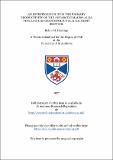Files in this item
An investigation into the primary productivity of the Antarctic macro-alga phyllogigas grandifolius (A. & E.S. Gepp) Skottsb
Item metadata
| dc.contributor.advisor | Drew, E. A. | |
| dc.contributor.author | Hastings, Robin M. | |
| dc.coverage.spatial | 172 p. | en_US |
| dc.date.accessioned | 2018-06-18T15:55:17Z | |
| dc.date.available | 2018-06-18T15:55:17Z | |
| dc.date.issued | 1977 | |
| dc.identifier.uri | https://hdl.handle.net/10023/14218 | |
| dc.description.abstract | The productivity of the large brown alga Phyllogigas grandifolius (A. & E.S. Gepp) Skottsb. has been studied over a period of 2 ½ years. This alga is endemic to the Antarctic and circumpolar in distribution. Photosynthesis was measured in situ using SCUBA, Uptake of 14C-labelled sodium bicarbonate was used to obtain values for gross photosynthesis throughout the year, and by monitoring respiration at the same time using the Winkler technique a value for daily accretion could be found. The curves for daily accretion showed only one mm maximum per season, that at the deeper of the two sites occurring later than at the shallow site, as the light levels reaching the deeper algae continued to increase. Positive accretion expressed in mugC. cm-2.d-1 was observed only during the summer months. Maxima in 1974 were 70 mugC. cm-2.d-1 at the shallow site and 56 at the deep site. Respiration was low throughout the year as a result of the small annual range of water temperature (+1.5°C to -2°C). The mean respiratory rate was found to be 1.55 mugC. cm-2.h-1 Variation in the rate was observed along the length of the frond with the maximum occurring in the region of the meristem about 10cm. above the base of the frond. In situ studies of frond growth showed a complete cessation of growth during the winter months but recommenced before the departure of the sea-ice. This and day length appear to be the two main limiting factors of growth. Mean growth rate: 8.0mm. wk-1. With the growing season restricted, to 6 months, the mean productivity for that season was found to be 2.4 g C.m-2.d-1, with a photosynthetic efficiency of 14%. In the winter this efficiency drops to 1%. These figures were obtained from bomb calorimetry studies. Mannitol, the main storage product and primary respiratory substrate showed summer maxima of around 18% dry weight, falling to 2% during the winter. Due to the irregular distribution of the alga, biomass estimates are rather subjective. One of the denser 'stands' of Phyllogigas gave a figure of 0.813 kg. m-2 and a Leaf Area Index of 4.5. Other LAI values were as low as 0.0028. The mean SLA was 0.075. The net annual primary productivity was found to be 15.3 metric tons, hectare-1 year-1. | en_US |
| dc.language.iso | en | en_US |
| dc.publisher | University of St Andrews | |
| dc.subject.lcc | QK580.5H2 | en |
| dc.subject.lcsh | Marine algae culture | en |
| dc.title | An investigation into the primary productivity of the Antarctic macro-alga phyllogigas grandifolius (A. & E.S. Gepp) Skottsb | en_US |
| dc.type | Thesis | en_US |
| dc.type.qualificationlevel | Doctoral | en_US |
| dc.type.qualificationname | PhD Doctor of Philosophy | en_US |
| dc.publisher.institution | The University of St Andrews | en_US |
This item appears in the following Collection(s)
Items in the St Andrews Research Repository are protected by copyright, with all rights reserved, unless otherwise indicated.

